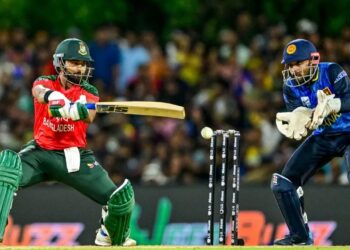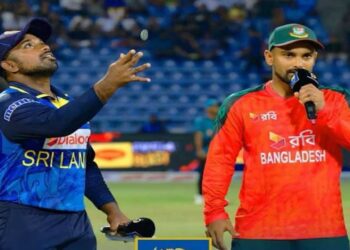By Azad Majumder
On September 30, 2014 a silent revolution held in Bangladesh cricket as the Bangladesh Cricket Board split the National team captaincy between Mashrafe Mortaza and Mushfiqur Rahim. Never in their wildest dream had the BCB officials imagined that the decision was going to have such an impact, something that would change the country’s cricketing landscape forever.
The idea was to reduce the pressure from Mushfiqur Rahim, who until that period of the year was unable to lead the Tigers to a single win against a Test playing country in any format. In one-day internationals they came close at least twice, respectively against Sri Lanka and India, but lacked the penetrating power that would earn them the coveted win. A Twenty20 International and an ODI defeat to Hong Kong and Afghanistan respectively did not help their reputation either.
The BCB had changed the coach but it did nothing to change the team’s fate. Removing Mushfiq from captaincy was one option the BCB had considered on few occasions but again there was no one who could lead the side in all three formats. The best possible solution for them was to split the captaincy and it did that without little hesitation.
By the time Mortaza took the charge of ODI team, Mushfiq already broke his year-long duck against a Test side leading Bangladesh to 3-0 success in a Test series against Zimbabwe. The series was competitive more than this year’s Ashes, so to come out winners gave them their confidence back. Mortaza took the helm of a winning team that was not prepared to look back. Bangladesh predictably whitewashed Zimbabwe in ODIs to go to the World Cup in Australia and New Zealand two months later with fresh bodies and mind.
What followed next 12 months was a kind of fairytale as Bangladesh knocked out England to reach World Cup quarter-final and won three back-to-back ODI series at home against Pakistan, India and South Africa. Their Test record in year is still modest but in ODIs they have drawn a comparison with Sri Lanka’s 1996 World Cup winners, qualified for the 2017 ICC Champions Trophy at the expense of West Indies and cemented their position at the seventh place in ICC ODI rankings.
But it was not an easy journey for the Tigers whatsoever. A defeat in a warm-up match against Ireland before the World Cup gave an ominous signal for them at the Down Under. They were under pressure in the opening game against Afghanistan, lost badly to Sri Lanka at the MCG before things finally started shaping up against Scotland with a record chase.
There are many factors that contributed to Bangladesh’s reverse result in 2015 than the preceding year. Former national captain Habibul Bashar, who watched the side from a very close range as a selector during both years, highlighted the captaincy issue mostly. “Mashrafee (Mortaza) is one who made the difference,” said Bashar. “Under his captaincy, the team is playing as a unit. Also we have some young players who performed really well. Mustafiz is one big revelation. Soumya (Sarkar) and Taskin (Ahmed) also did a great job. They reduced the burden from Shakib (Al Hasan) and Tamim (Iqbal). Coaching management also played a huge role. Our head coach Hathurusinghe successfully got rid of individualism in the team.”
The role of Mortaza in Bangladesh’s positive change is undisputed. By far the most senior player, he commands respect from every cricketer in the dressing room and as one of the bowling spearheads always led from the front. For someone, who had seven surgeries on both of his knees, it was huge challenge not just as a captain, but also as a player. With lot of players pushing for a place, he had to perform well to survive in the team and Mortaza did that in spectacular fashion. Never on a single occasion had he given an impression that he was playing merely as captain.
If someone can do that as captain it certainly inspires others. Mortaza has always been a popular figure in the team for his extrovert nature ever since he made his international debut. The team’s young players like Soumya, Taskin, Mustafiz and Sabbir, Liton Das felt welcomed under his captaincy and they made a huge impact. Mortaza also always backed team’s strength. When Mushfiq fielded four spinners against India in Test, Mortaza dared to take four seamers against the same side in ODIs. One of the four quicks was Mustafiz, the revelation of the year, whose deadly off-cutters left some of the best batsmen in the world bamboozled throughout the year. If Mortaza was not the captain, Mustafiz surely had to wait a little longer to make his debut.
The BCB seemed indebted to coach Hathurusinghe as well for bringing the discipline in the team. Hathurusinghe’s predecessor Shane Jurgensen was known as soft character, one, who could not tell the senior players to do certain things. The islander got an idea of what he needs to do during a telephonic conversation with Shakib Al Hasan shortly after his arrival. Shakib was on his way to Caribbean Premier League when he received the call from the coach. Hathurusinghe asked him to return to a certain date but Shakib was not ready to listen. The resulting events earned Shakib six-month ban and helped Hathurusinghe establish his authority in the team.
Hathurusinghe also showed Abdur Razzak the door after a prolonged streak of poor form, something which Jurgensen could not do in the Asia Cup and in the ICC World Twenty20. “Hathurusinghe’s modus operandi is different than many other coaches,” said BCB director Jalal Yunus. “He brought discipline in the team. In the past players would dictate training schedule. Now it cannot happen.”
While Mortaza gave the team a “feel good” atmosphere, Hathurusinghe ensured nobody relaxed. The combination of these two elements revolutionised Bangladesh’s cricket in 2015.
-http://cricwizz.com











Discussion about this post